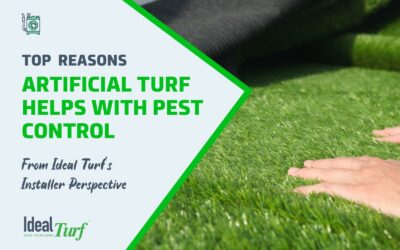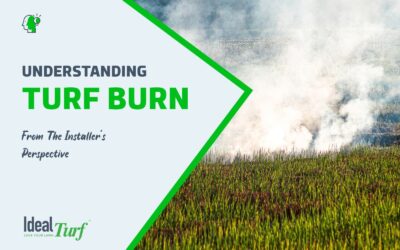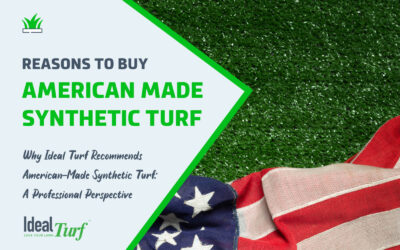Dog Run Cleaning & Maintenance: A Complete Pet Turf Cleaning Guide

Did you know that owning a dog has been scientifically proven to improve your health?
- Washington State University determined that just 10 minutes of petting a dog can lower blood pressure and heart rate and release muscle tension.
- Purdue’s College of Veterinary Medicine found that military veterans experiencing PTSD do better both physically and psychologically when they have a dog.
- Owning a dog is good for your love life, too! In a series of studies, men were more likely to get a woman’s phone number when they had a dog with them.
- And a study by Pet Wingman found that men and women “swipe right” on dating apps more when they include a profile photo of their pup.
With dogs giving so much love and benefit to us, of course, we want to give just as much back to them!
One way to do so is to keep your dog happy and healthy by providing an artificial grass backyard or dog run that’s cleaned and maintained on a regular basis.
A dog run will provide your dog(s) with their own space where they can take a time out when there is too much activity or where you can put them when they cannot be running loose.
We published a detailed guide about dog run ideas and one about creating a dog-friendly backyard that you may find helpful.
In this article, we’ll go over dog run cleaning and maintenance, explaining how to clean and maintain an artificial turf dog run and provide an effective daily, weekly, monthly, and annual routine for keeping your pet-friendly turf clean.

How To Clean & Maintain An Artificial Turf Dog Run
Although pet urine is 95% water, the other 5% is a combination of uric acid, urea, ammonia, proteins, salts, minerals, and toxins.
Uric acid crystals don’t dissolve or decompose – they just mix with those other chemicals and stay put.
That’s what causes the brown dog urine spots in natural grass lawns and it’s why the odor stays around for a long time if you don’t take steps to neutralize it.
Cleaning synthetic grass is easy and artificial turf maintenance is simple.
Our recommendations are based generally on a single dog.
If you have more, you may find that you need to repeat some tasks more frequently.

Daily Dog Run Cleaning & Maintenance Tasks
The most important daily contribution you can make to your dog’s ongoing physical health is to make sure they have plenty of fresh, clean water and nutritious food.
After that, make sure they have lots of reasonably clean space in which to play and a well-maintained area in which to do their business.
Plan to check the artificial grass in your dog run or backyard at least once a day for the presence of solid waste
Solid waste is removed from fake grass for dogs the same way it’s picked up from natural grass.
Let it sit there long enough to dry slightly so that picking it up won’t rub it into the synthetic grass blades.
If you do happen to have some solid waste become trapped in the blades of your synthetic turf, spray it with a mild detergent cleaner, let it sit a moment, and then wipe thoroughly.
While inspecting the yard or dog run for waste, check also for any debris or objects which could harm either the dog or the turf, and remove the objects before they can do any damage.

Weekly Dog Run Cleaning & Maintenance Tasks
Once a week, after completing the routine daily cleaning and maintenance tasks for that day, perform the following additional tasks:
- First, pick up any debris or solid waste that you find on the turf.
- Pick up your dog’s water and food bowls.
- Take your garden hose and spray down the entire yard or dog run.
- Wet the surface thoroughly and pay special attention to spots where you know your dog is most likely to urinate.
- While it’s drying, clean the water and food bowls thoroughly, refill them, and return them to their normal locations.
- Make sure that whatever shade you have provided outdoors for your dog is still effective, particularly during hotter months.
- Make sure that any structure designed to protect your dog when outside in the rain is not leaking.
If you have more than one dog, or during the hotter and drier seasons, you may find that you need to spot treat occasionally with a urine deodorizer to maintain odor control in-between rinses.

Monthly Dog Run Cleaning & Maintenance Tasks
Once a month, after completing the normal weekly cleaning and maintenance routine for that week, perform the following additional tasks:
- Spray the entire backyard or dog run with a commercial or homemade urine odor deodorizer.
- An effective deodorizer can be made at home by mixing 50% vinegar with 50% clear water.
- Let the deodorizer dry on the surface – no need to rinse it off.
- Once it has dried, use a stiff-bristled push broom to fluff up the fibers in your artificial grass. This keeps it looking naturally beautiful.
- Clean and sanitize your dog’s soft toys by putting them in the dishwasher or washing machine set to hot water. Hard toys can go into a bucket of hot soapy water or into the washing machine.
- This lessens germs, makes them easier for the dog to play with, and gives you a chance to inspect the toys for any damage that could harm your dog.
It’s also time to clean the dog’s bedding, whether kept indoors or out, by following the manufacturer’s instructions.

Yearly Dog Run Cleaning & Maintenance Tasks
The annual dog run cleaning and maintenance routine is similar to conducting a spring cleaning for your house.
Once a year, after you’ve finished both the weekly and monthly dog run cleaning and maintenance routines for your backyard artificial turf or dog run, perform the following additional tasks:
- Replenish the infill material for your artificial turf. This helps the grass blades stand up and return to their intended position after being exposed to pressure. Infill also helps protect your synthetic turf from UV damage.
- Consider replacing your dog beds. After being washed on a monthly basis, they are probably pretty ragged by now.
- Repair any structural issues that may have arisen over the past year, such as loose hinges on a gate, cracks in concrete, or loose patio tiles.
- Consider giving any painted or stained surfaces a fresh coat of paint to protect the surfaces and improve the appearance of your backyard or dog run.
- Inspect lawn and patio furniture and fix or replace anything that appears to need it.
- Check your dog house or agility equipment for any repairs that may be needed.

Wrapping Up Our Dog Run Cleaning & Maintenance Guide
Left to its own devices, dog urine can begin causing an odor in your artificial turf backyard or dog run after about a week.
Fortunately, this is very easy to rinse away.
Man’s best friend deserves your best.
That’s why you installed or are considering installing artificial grass in your backyard or dog run to begin with.
It’s beautifully green, natural-looking, cost-effective, safe, and amazingly low-maintenance.
However, low maintenance isn’t the same as zero maintenance.
But by following a simple daily, weekly, monthly, and yearly dog run cleaning and maintenance routine as we’ve outlined above, you can keep your turf looking its best.
For a FREE artificial grass design and installation estimate for your backyard or dog run, contact Ideal Turf.
As the leading artificial grass company in Texas & Oklahoma, we can help you choose the turf product best suited for your needs and professionally install it for decades of worry-free use.
Click the “GET A QUOTE” button or feel free to give us a call at 800-204-4650.
Recent Posts
- How Synthetic Turf Helps Keep Fleas and Ticks Out of Your Texas and Oklahoma Yard
- Porches, Patios & Personality: Creating Outdoor Spaces Texans Love
- Turn Your Backyard into a Golfer’s Dream: Custom Putting Greens by Ideal Turf
- Why Texas Pet Owners Are Choosing Pet-Friendly Artificial Grass from Ideal Turf
- Why More Texans and Oklahomans Are Turning to Artificial Grass for a Greener Future






